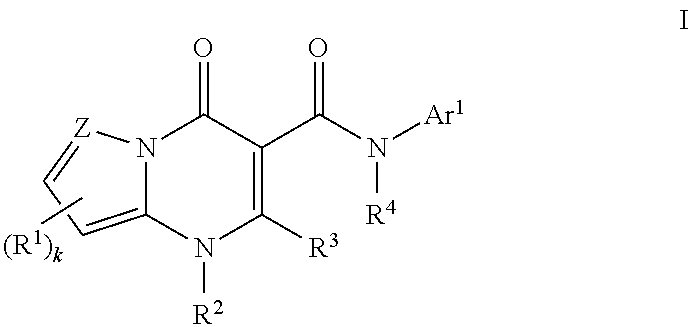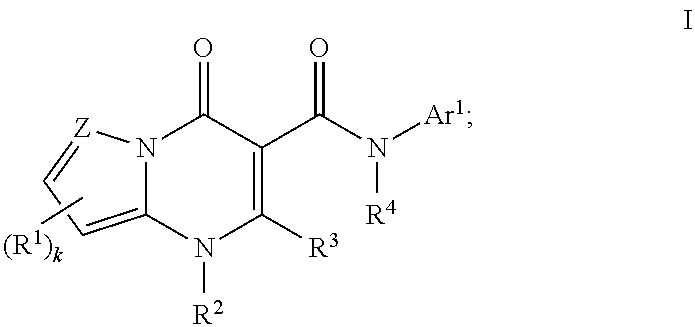Modulators of cystic fibrosis transmembrane conductance regulator
a technology of transmembrane conductance and cystic fibrosis, which is applied in the field of modulators of cystic fibrosis transmembrane conductance regulators, can solve the problems of imbalance in ion and fluid transport, debilitating and fatal effects of cf, and individual with two copies of the cf associated gene suffer from the debilitating and fatal effects of cf, and achieves the effect of lessening the severity
- Summary
- Abstract
- Description
- Claims
- Application Information
AI Technical Summary
Benefits of technology
Problems solved by technology
Method used
Image
Examples
example 1
Preparation of N-(2,4-di-tert-butyl-5-hydroxyphenyl)-7-ethyl-4-oxo-1,4-dihydropyrrolo[1,2-a]pyrimidine-3-carboxamide (Compound 14, Table 1)
[0218]
[0219]Ethyl 4-hydroxy-2-methylpyrimidine-5-carboxylate (1.5 g, 8.234 mmol) was suspended in DME (48 mL) and TBAF (13.17 mL, 1 M solution in THF, 13.17 mmol) was added dropwise at 0° C. The resulting solution was stirred for 10 minutes and a solution of 1-bromo-2-butanone (1.318 g, 8.728 mmol) in DME (3 mL) was added dropwise. The reaction was stirred at room temperature overnight. The solution was then concentrated in vacuo and partitioned between EtOAc and saturated aqueous NH4Cl. The EtOAc layer was separated, dried over Na2SO4 and concentrated in vacuo to give an oil. The crude material was purified by flash chromatography 0-100% EtOAc / hexanes to obtain pure desired product, ethyl 2-methyl-6-oxo-1-(2-oxobutyl)-1,6-dihydropyrimidine-5-carboxylate, as an off white solid; 1.73 g (83%). LC / MS (10-99% CH3CN / 0.05% TFA in H2O / 0.05% TFA gradient...
example 2
Preparation of N-(2,4-di-tert-butyl-5-hydroxyphenyl)-7-oxo-4,7-dihydropyrazolo[1,5-a]pyrimidine-6-carboxamide (Compound 5, Table 1)
[0223]
[0224]A mixture of 1H-pyrazol-5-amine 1 (2 g, 24.1 mmol) and diethyl 2-(ethoxymethylene)malonate (10.4 g, 48.2 mmol) was heated at 200° C. until the starting material was consumed completely. The reaction mixture was allowed to cool to room temperature and EtOH (10 mL) was added. A precipitate formed, which was removed by filtration, washed with EtOH and dried under vacuum to give diethyl 2-((1H-pyrazol-5-ylamino)methylene)malonate; 4.0 g (66%). 1H NMR (300 MHz, CDCl3) δ 10.95 (d, J=13.5 Hz, 1H), 8.60 (d, J=13.8 Hz, 1H), 7.52 (d, J=2.4 Hz, 1H), 6.08 (d, J=2.4 Hz, 1H), 4.30 (q, J=7.2 Hz, 2H), 4.22 (q, J=7.2 Hz, 2H), 1.36 (t, J=7.2 Hz, 3H), 1.31 (t, J=7.2 Hz, 3H).
[0225]A solution of the 2-((1H-pyrazol-5-ylamino)methylene)malonate (4.0 g, 15.8 mmol) in Dowtherm (15 mL) was heated to 250° C. for 2 hours. The reaction mixture was allowed to cool to room...
example 3
Synthesis of 2-amino-5-cyclopentyl-4-hydroxybenzonitrile
[0228]
[0229]To a stirring solution of 2-cyclopentyl phenol (7.9 g, 48.7 mmol) in acetic acid (32 mL) and water (16 mL) was added HBr (33% in AcOH, 50.45 mL, 292.2 mmol) followed by the dropwise addition of DMSO (34.8 g, 31.6 mL, 445.0 mmol) over 10 min. The reaction was quenched with saturated aqueous NaHCO3 and concentrated in vacuo to remove gasses. The residue was brought up in ether (200 mL), washed with water (2×100 mL) and brine (100 mL) then dried over Na2SO4. The solution was filtered and concentrated in vacuo to produce an oil which was purified by silica gel chromatography (0-10% ethyl acetate / hexane) to provide 4-bromo-2-cyclopentylphenol (10.5 g, 89% yield) as a colorless oil. 1H NMR (400.0 MHz, DMSO-d6) δ 9.59 (s, 1H), 7.20 (d, J=2.5 Hz, 1H), 7.13 (dd, J=2.5, 8.5 Hz, 1H), 6.73 (d, J=8.5 Hz, 1H), 3.21-3.13 (m, 1H), 1.95-1.88 (m, 2H), 1.77-1.69 (m, 2H), 1.65-1.44 (m, 4H).
[0230]4-Bromo-2-cyclopentylphenol (10.0 g, 41....
PUM
| Property | Measurement | Unit |
|---|---|---|
| Frequency | aaaaa | aaaaa |
| Frequency | aaaaa | aaaaa |
| Frequency | aaaaa | aaaaa |
Abstract
Description
Claims
Application Information
 Login to View More
Login to View More - R&D
- Intellectual Property
- Life Sciences
- Materials
- Tech Scout
- Unparalleled Data Quality
- Higher Quality Content
- 60% Fewer Hallucinations
Browse by: Latest US Patents, China's latest patents, Technical Efficacy Thesaurus, Application Domain, Technology Topic, Popular Technical Reports.
© 2025 PatSnap. All rights reserved.Legal|Privacy policy|Modern Slavery Act Transparency Statement|Sitemap|About US| Contact US: help@patsnap.com



